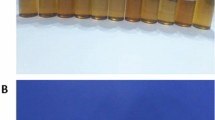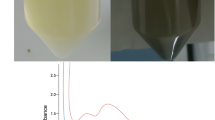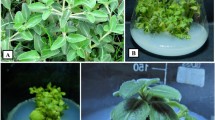Abstract
Cinnamomum tamala is Indian bay leaves also known as Tej patta commonly used in the preparation of delicious food for its sweet aroma and tremendous medicinal values. In this study, the significant concentration-dependent free radical scavenging and antioxidant efficacy of the aqueous extracts of bay leaves has been determined using DPPH (2, 2-diphenyl-l-picrylhydrazyl) radical scavenging, ferric ion-reducing power assay, and hydrogen peroxide radical scavenging assay. The leaf extract has also been utilized in the rapid synthesis of silver nanoparticles (AgNPs) under mild conditions (30 min reaction time at 70 °C) without the addition of extra stabilizing or capping agents. Mostly spherical shaped particles were formed with diameter ranging from 10 to 12 nm as evident by HRTEM imaging. The silver nanoparticles were also characterized using FTIR, XRD, and UV-visible spectroscopic techniques. The antibacterial effect of the synthesized AgNPs was studied against three clinically isolated multidrug-resistant bacterial strains (Escherichia coli (EC-1), Klebsiella pneumonia (KP-1), and Staphylococcus aureus (SA-1)). The minimum inhibitory concentration (MIC) and minimum bactericidal concentration (MBC) of AgNPs against EC-1 were 12.5 and 15 μg/mL and in SA-1 were 10 and 50 μg/mL, and in the case of KP-1, both values were 12.5 μg/mL. It was also noted that 8 h treatment duration using AgNPs was sufficient to eliminate all types of bacterial growth as evidenced by time-dependent killing kinetic assays. The biocompatibilities of AgNPs were also tested against human health RBCs, and it was observed that it did not show any significant toxicity up to 50 μg/mL concentration.












Similar content being viewed by others
Abbreviations
- AgNPs:
-
Silver nanoparticles
- AR:
-
Analytical reagent
- AgNO3 :
-
Silver nitrate
- DAD:
-
Disk agar diffusion
- DPPH:
-
2,2-diphenyl-1-picrylhydrazyl
- EDX:
-
Energy dispersive X-Ray analysis
- EC-1:
-
Escherichia coli
- FTIR:
-
Fourier transform infrared spectroscopy
- HRTEM:
-
High-resolution transmission electron microscopy
- H2O2 :
-
Hydrogen peroxide
- KP-1:
-
Klebsiella pneumoniae
- MIC:
-
Minimum inhibitory concentration
- MBC:
-
Minimum bactericidal concentration
- NA:
-
Nutrient agar
- NB:
-
Nutrient broth
- PBS:
-
Phosphate buffer saline
- SA-1:
-
Staphylococcus aureus
- SAED:
-
Selected area (electron) diffraction
- UV-Vis:
-
Ultraviolet-visible spectroscopy
- XRD:
-
X-ray powder diffraction
References
Wang C, Gao X, Chen Z, Chen Y, Chen H (2017) Preparation, characterization and application of polysaccharide-based metallic nanoparticles: a review. Polymers 9:689
Siddiqi KS, Husen A, Rao RA (2018) A review on biosynthesis of silver nanoparticles and their biocidal properties. J Nanobiotechnol 16:14
Rashid MU, Bhuiyan MKH, Quayum ME (2013) Synthesis of silver nano particles (Ag-NPs) and their uses for quantitative analysis of vitamin C tablets. Dhaka Univ J Pharm Sci 12:29–33
Nakhjavani M, Nikkhah V, Sarafraz MM, Shoja S, Sarafraz M (2017) Green synthesis of silver nanoparticles using green tea leaves: experimental study on the morphological, rheological and antibacterial behaviour. Heat Mass Transf 53(10):3201–3209
Geetha N, Geetha TS, Manonmani P, Thiyagarajan M (2014) Green synthesis of silver nanoparticles using Cymbopogon citratus (Dc) Stapf. extract and its antibacterial activity. Aus J Basic Appl Sci 8:324–321
Narayanan KB, Park HH (2014) Antifungal activity of silver nanoparticles synthesized using turnip leaf extract (Brassica rapa L.) against wood rotting pathogens. Eur J Plant Pathol 140:185–192
Kathiravan V, Ravi S, Ashokkumar S (2014) Synthesis of silver nanoparticles from Melia dubia leaf extract and their in vitro anticancer activity. Spectrochim Acta A Mol Biomol Spectrosc 130:116–121
Chintamani RB, Salunkhe KS, Chavan MJ (2018) Emerging use of green synthesis silver nanoparticle: an updated review. Int J Pharm Sci Res 9:4029–4055
Syafiuddin A, Salim MR, Beng Hong Kueh A, Hadibarata T, Nur H (2017) A review of silver nanoparticles: Research trends, global consumption, synthesis, properties, and future challenges. J Chin Chem 64:732–756
Dakal TC, Kumar A, Majumdar RS, Yadav V (2016) Mechanistic basis of antimicrobial actions of silver nanoparticles. Front Microbiol 7:1831
Stoimenov PK, Klinger RL, Marchin GL, Klabunde KJ (2002) Metal oxide nanoparticles as bactericidal agents. Langmuir. 18(17):6679–6686
Yamanaka M, Hara K, Kudo J (2005) Bactericidal actions of a silver ion solution on Escherichia coli, studied by energy-filtering transmission electron microscopy and proteomic analysis. Appl Environ Microbiol 71(11):7589–7593
He D, Jones AM, Garg S, Pham AN, Waite TD (2011) Silver nanoparticle−reactive oxygen species interactions: application of a charging− discharging model. J Phys Chem C 115(13):5461–5468
Kim JS, Kuk E, Yu KN, Kim JH, Park SJ, Lee HJ, Kim SH, Park YK, Park YH, Hwang CY, Kim YK (2007) Antimicrobial effects of silver nanoparticles. Nanomedicine 3(1):95–101
Morones JR, Elechiguerra JL, Camacho A, Holt K, Kouri JB, Ramírez JT, Yacaman MJ (2005) The bactericidal effect of silver nanoparticles. Nanotechnology. 16(10):2346–2353
Adhikary J, Chakraborty P, Das B, Datta A, Dash SK, Roy S, Chen JW, Chattopadhyay T (2015) Preparation and characterization of ferromagnetic nickel oxide nanoparticles from three different precursors:application in drug delivery. RSC Adv 5(45):35917–35928
Firdhouse MJ, Lalitha P (2015) Biosynthesis of silver nanoparticles and its applications. Journal of Nanotechnology 2015
Singh R, Singh D (2014) Chitin membranes containing silver nanoparticles for wound dressing application. Int Wound J 11(3):264–268
Kaur J, Tikoo K (2013) Evaluating cell specific cytotoxicity of differentially charged silver nanoparticles. Food Chem Toxicol 51:1–4
Latha D, Prabu P, Gnanamoorthy G, Sampurnam S, Manikandan R, Arulvasu C, Narayanan V (2019) Facile Justicia adhatoda leaf extract derived route to silver nanoparticle: synthesis, characterization and its application in photocatalytic and anticancer activity. Mater Res Exp 6(4):045003
Hassan W, Zainab KS, Noreen H, Riaz A, Zaman B (2016) Antimicrobial activity of cinnamomum tamala leaves. J Nutr Disord Ther 6:2161–0509
Datkhile KD, Durgawale PP, PatilMN (2017) Biogenic silver nanoparticles are equally cytotoxic as chemically synthesized silver nanoparticles. Biomed Pharmacol J 10(1):337–344
Banerjee J, Dey S, Rizowana HN, Samanta S, Dutta R, Kundu P, Kole L, Giri B, Dash SK (2019) Evaluation of antimicrobial activities of commercial product (RH 5) and its competitor products against clinically isolated bacterial strains and bacterial population present in poultry bed
Sasikumar V, Kalaisezhiyen P (2014) Evaluation of free radical scavenging activity of various leaf extracts from Kedrostis foetidissima (Jacq.). Cogn. Biochem Anal Biochem:3
Wu J, Li P, Tao D, Zhao H, Sun R, Ma F, Zhang B (2018) Effect of solution plasma process with hydrogen peroxide on the degradation and antioxidant activity of polysaccharide from Auricularia auricular. Int J Biol Macromol 117:1299–1304
CLSI (2019) In: Performance standards for antimicrobial susceptibility testing. 29th ed. Wayne, PA: Clinical and Laboratory Standards Institute; CLSI supplement M100
Das B, Mandal D, Dash SK, Chattopadhyay S, Tripathy S, Dolai DP, Dey SK, Roy S (2016) Eugenol provokes ROS-mediated membrane damage-associated antibacterial activity against clinically isolated multidrug-resistant Staphylococcus aureus strains. Infect Dis Res Treat 9:IDRT–S31741
Mandal D, Dash SK, Das B, Chattopadhyay S, Ghosh T, Das D, Roy S (2016) Bio-fabricated silver nanoparticles preferentially targets Gram positive depending on cell surface charge. Biomed Pharmacother 83:548–558
Das B, Dash SK, Mandal D, Ghosh T, Chattopadhyay S, Tripathy S, Das S, Dey SK, Das D, Roy S (2017) Green synthesized silver nanoparticles destroy multidrug resistant bacteria via reactive oxygenspeciesmediatedmembrane damage.Arab J Chem10:862–876
Dehpour AA, Ebrahimzadeh MA, Fazel NS, Mohammad NS (2009) Antioxidant activity of the methanol extract of Ferula assafoetida and its essential oil composition. Grasas Aceites 60:405–412
Pena AK, Camara JS (2019) Antioxidant activity of talahib (Saccharum spontaneum) leaves ethanolic extract through DPPH assay. Philippine J Nat Soc Sci 1(1)
Sudan R, Bhagat M, Gupta S, Devi T (2013) Comparative analysis of cytotoxic and antioxidant potential of edible Cinnamomum verum (bark) and Cinnamomum tamala (Indian bay leaf). Free Radicals and Antioxid 3:S70–S73
Meir S, Kanner J, Akiri B, Philosoph-Hadas S (1995) Determination and involvement of aqueous reducing compounds in oxidative defense systems of various senescing leaves. J Agric Food Chem 43:1813–1819
El Jemli M, Kamal R, Marmouzi I, Zerrouki A, Cherrah Y, Alaoui K (2016) Radical-scavenging activity and ferric reducing ability of Juniperus thurifera (L.), J. oxycedrus (L.), J. phoenicea (L.) and Tetraclinis articulata (L.). Adv Pharmacol Sci 2016
Phaniendra A, Jestadi DB, Periyasamy L (2015) Free radicals:properties, sources, targets, and their implication in various diseases. Indian J Clin Biochem 30:11–26
Bendary E, Francis RR, Ali HMG, Sarwat MI, El Hady S (2013) Antioxidant and structure–activity relationships (SARs) of some phenolic and anilines compounds. Ann Agric 58:173–181
Bhagat M, Anand R, Datt R, Gupta V, Arya S (2019) Green synthesis of silver nanoparticles using aqueous extract of Rosa brunonii Lindl and their morphological, biological and photocatalytic characterizations. J Inorg Organomet Polym Mater 29(3):1039–1047
Femi-Adepoju AG, Dada AO, Otun KO, Adepoju AO, Fatoba OP (2019) Green synthesis of silver nanoparticles using terrestrial fern (Gleichenia pectinata (Willd.) C. Presl.): characterization and antimicrobial studies. Heliyon 5(4):e01543
Tripathy S, Rademan S, Matsabisa MG (2019) Effects of silver nanoparticle from Dicoma anomala Sond. Root extract on MCF-7 cancer cell line and NF54 parasite strain: an in vitro study. Biol Trace Elem Res 16
Meva FE, Mbeng JO, Ebongue CO, Schlüsener C, Kök am-Demir Ü, Ntoumba AA, Kedi PB, Elanga E, Loudang ER, Nko’o MH, Tchoumbi E (2019) Stachytarpheta cayennensis aqueous extract, a new bioreactor towards silver nanoparticles for biomedical applications. J Biomater Nanobiotechnol 10(02):102
Anandan M, Poorani G, Boomi P, Varunkumar K, Anand K, Chuturgoon AA, Saravanan M, Prabu HG (2019) Green synthesis of anisotropic silver nanoparticles from the aqueous leaf extract of Dodonaea viscosa with their antibacterial and anticancer activities. Process Biochem 80:80–88
Kubo AL, Capjak I, Vrček IV, Bondarenko OM, Kurvet I, Vija H, Ivask A, Kasemets K, Kahru A (2018) Antimicrobial potency of differently coated 10 and 50 nm silver nanoparticles against clinically relevant bacteria Escherichia coli and Staphylococcus aureus. Colloids Surf B: Biointerfaces 170:401–410
Loo YY, Rukayadi Y, Nor-Khaizura MA, Kuan CH, Chieng BW, Nishibuchi M, Radu S (2018) In vitro antimicrobial activity of green synthesized silver nanoparticles against selected gram-negative foodborne pathogens. Front Microbiol 9:1555
Zgurskaya HI, Lopez CA, Gnanakaran S (2015) Permeability barrier of Gram-negative cell envelopes and approaches to bypass it. ACS Infect Dis 1:512–522
Grillon A, Schramm F, Kleinberg M, Jehl F (2016) Comparative activity of ciprofloxacin, levofloxacin and moxifloxacin against Klebsiella pneumoniae, Pseudomonas aeruginosa and Stenotrophomonas maltophilia assessed by minimum inhibitory concentrations and time-kill studies. PloS One 11(6)
Vijayakumar S, Malaikozhundan B, Saravanakumar K, Durán-Lara EF, Wang MH, Vaseeharan B (2019) Garlic clove extract assisted silver nanoparticle–antibacterial, antibiofilm, antihelminthic, antiinflammatory, anticancer and ecotoxicity assessment. J Photochem Photobiol B Biol 198:111558
Kairyte K, Kadys A, Luksiene Z (2013) Antibacterial and antifungal activity of photoactivated ZnO nanoparticles in suspension. J Photochem Photobiol B Biol 128:78–84
Khalandi B, Asadi N, Milani M, Davaran S, Abadi AJ, Abasi E, Akbarzadeh A (2017) A review on potential role of silver nanoparticles and possible mechanisms of their actions on bacteria. Drug Res 11(02):70–76
Sirelkhatim A, Mahmud S, Seeni A, Kaus NH, Ann LC, Bakhori SK, Hasan H, Mohamad D (2015) Review on zinc oxide nanoparticles:antibacterial activity and toxicity mechanism. Nano-Micro Lett 7(3):219–242
Boateng J, CatanzanoO (2020) Silver and silver nanoparticle-based antimicrobial dressings. Therapeutic Dressings and Wound Healing Applications 2:157–184
Yun’an Qing LC, Li R, Liu G, Zhang Y, Tang X, Wang J, Liu H, Qin Y (2018) Potential antibacterial mechanism of silver nanoparticles and the optimization of orthopedic implants by advanced modification technologies. Int J Nanomedicine 13:3311
Limoli DH, Jones CJ, Wozniak DJ (2015) Bacterial extracellular polysaccharides in biofilm formation and function. Microbiol Spectr 3
Kulasakara H, Lee V, Brencic A, Liberati N, Urbach J, Miyata S, Lee DG, Neely AN, Hyodo M, Hayakawa Y, Asubel FM, Lory S (2006) Analysis of Pseudomonas aeruginosa diguanylate cyclases and phosphodiesterases reveals a role for bis-(3′-5′)-cyclic-GMP in virulence. Proc Natl Acad Sci U S A 103:2839–2844
Landini P, Antoniani D, Burgess JG, Nijland R (2010) Molecular mechanisms of compounds affecting bacterial biofilm formation and dispersal. Appl Microbiol Biotechnol 86(3):813–823
Simm R, MorrM KA, NimtizM RU (2004) GGDEF and EAL domains inversely regulate cyclic di-GMP levels and transition from sessility to motility. Mol Microbiol 53:1123–1134
Sudarsan N, Lee ER, Weinberg Z, Moy RH, Kim JN, Link KH, Breaker RR (2008) Riboswitches in eubacteria sense the second messenger cyclic di-GMP. Science 321:411–413
Weber H, Pesavento C, Possling A, Tischendorf G, Hengge R (2006) Cyclic-di-GMP-mediated signalling within the sigma network of Escherichia coli. Mol Microbiol 62:1014–1034a
Weinhouse H, Sapir S, Amikam D, Shilo Y, Volman G, Ohana P, Benziman M (1997) c-di-GMP-binding protein, a new factor regulating cellulose synthesis in Acetobacter xylinum. FEBS Lett 416:207–211
Kim NY, Yim T, Song JH, Yu JS, Lee Z (2016) Microstructural study on degradation mechanism of layered LiNi0. 6Co0. 2Mn0. 2O2 cathode materials by analytical transmission electron microscopy. J Power Sources 307:641–648
Adebayo-Tayo B, Salaam A, Ajibade A (2019) Green synthesis of silver nanoparticle using Oscillatoria sp. extract, its antibacterial, antibiofilm potential and cytotoxicity activity. Heliyon 5(10):e02502
Charlebois A, Jacques M, Archambault M (2014) Biofilm formation of Clostridium perfringens and its exposure to low-dose antimicrobials. Front Microbiol 5:183
Park HJ, Kim HY, Cha S, Ahn CH, Roh J, Park S, Kim S, Choi K, Yi J, Kim Y, Yoon J (2013) Removal characteristics of engineered nanoparticles by activated sludge. Chemosphere. 92(5):524–528
Appiah T, Boakye YD, Agyare C (2017) Antimicrobial activities and time-kill kinetics of extracts of selected ghanaian mushrooms. Evid Based Complement Alternat Med:2017
Jin JC, Wu XJ, Xu J, Wang BB, Jiang FL, Liu Y (2017) Ultrasmall silver nanoclusters: highly efficient antibacterial activity and their mechanisms. Biomater Sci 5(2):247–257
Zhong X, Song Y, Yang P, Wang Y, Jiang S, Zhang X, Li C (2016) Titanium surface priming with phase-transited lysozyme to establish a silver nanoparticle-loaded chitosan/hyaluronic acid antibacterial multilayer via layer-by-layer self-assembly. PLoS One 11(1)
Long YM, Hu LG, Yan XT, Zhao XC, Zhou QF, Cai Y, Jiang GB (2017) Surface ligand controls silver ion release of nanosilver and its antibacterial activity against Escherichia coli. Int J Nanomedicine 12:3193
Acknowledgments
The University of Gour Banga is highly acknowledged for giving me an opportunity to perform biological work at the department of Physiology.
Author information
Authors and Affiliations
Corresponding author
Ethics declarations
Conflict of Interest
The authors declare that they have no competing interest.
Additional information
Publisher’s Note
Springer Nature remains neutral with regard to jurisdictional claims in published maps and institutional affiliations.
Electronic supplementary material
ESM 1
(PDF 168 kb)
Rights and permissions
About this article
Cite this article
Dash, S.S., Samanta, S., Dey, S. et al. Rapid Green Synthesis of Biogenic Silver Nanoparticles Using Cinnamomum tamala Leaf Extract and its Potential Antimicrobial Application Against Clinically Isolated Multidrug-Resistant Bacterial Strains. Biol Trace Elem Res 198, 681–696 (2020). https://doi.org/10.1007/s12011-020-02107-w
Received:
Accepted:
Published:
Issue Date:
DOI: https://doi.org/10.1007/s12011-020-02107-w




